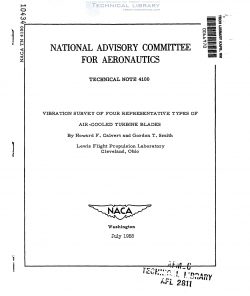naca-tn-4100
- Version
- 127 Downloads
- 1.11 MB File Size
- 1 File Count
- January 31, 2017 Create Date
- January 31, 2017 Last Updated
National Advisory Committee for Aeronautics, Technical Notes - Vibration Survey of Four Representative Types of Air-Cooled Turbine Blades

An investigation was conducted in a turbojet engine, mounted in a
sea-level test stand, to determine the vibrational characteristics of
four representative types of air-cooled turbine blades. Two of the types
were standard-span (4 in.) blades for the engine used in this investi-
gation, and the other two types were long-span (6% in.) blades for high
mass-flow turbines. Static fatigue tests were also conducted with these
blades. The blades were all brazed assemblies of cast and sheet—metal
components. The vibratory stresses Were measured with NASA high-
temperature strain gages.
In all four blade types, the first-bending-mode frequencies were in-
creased from 2 to 5 percent by a coolant-flow rate of approximately 8 per-
cent. With the standard—span blades, cooling had no noticeable effect on
the maximum vibratory stress measured; however, with the long-span.b1ades,
the vibratory stresses were reduced at high speeds by introducing cooling
air. Also, the long span—blades vibrated at all speeds and the vibratory
stresses increased rapidly with speed. The results of the long—spaanlade
tests may have been influenced by the testing conditions at the tip regions
of the blades.
The research on cooled turbine blades has experienced failures of
experimental blades in engines (refs. 1 to 4). Some of these failures
were attributed to fabrication and materials problems; however, other
failures exhibited signs of fatigue caused by blade vibrations. The
vibration prdblems associated with the hollow cooled turbine blades may
be significantly different from those for solid uncooled blades. This
vibratory stress problem in cooled turbine-rotor blades will become in-
creasingly important as the high Mach number, high mass flow, and low
pressure ratio turbojet engine is developed with inlet temperatures
ranging from 20000 to 25000 F. To handle the high mass flow, these
engines will have low turbine hub—tip radius ratios, and as the turbine
blades become longer to permit higher and higher mass flows, blade stiff-
ness will decrease, and the blades will be more susceptible to vibration.
Also, the high turbine speeds associated with the use of the transonic
compressor result in high centrifugal stresses. The anticipated combi-
nation of high levels of centrifugal and vibratory stresses establishes
a need to determine the vibratory characteristics of representative air-
cooled blades.
| File | Action |
|---|---|
| naca-tn-4100 Vibration Survey of Four Representative Types of Air-Cooled Turbine Blades.pdf | Download |

Comment On This Post